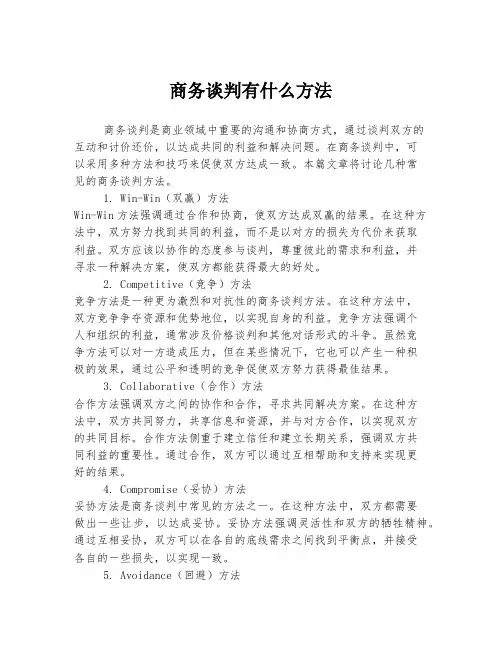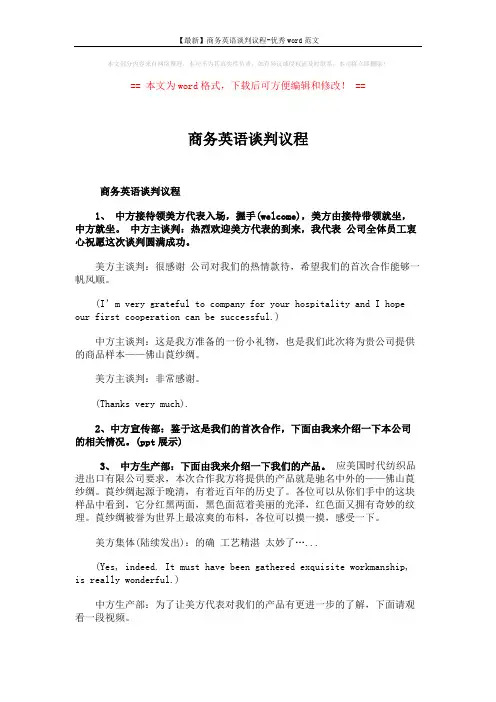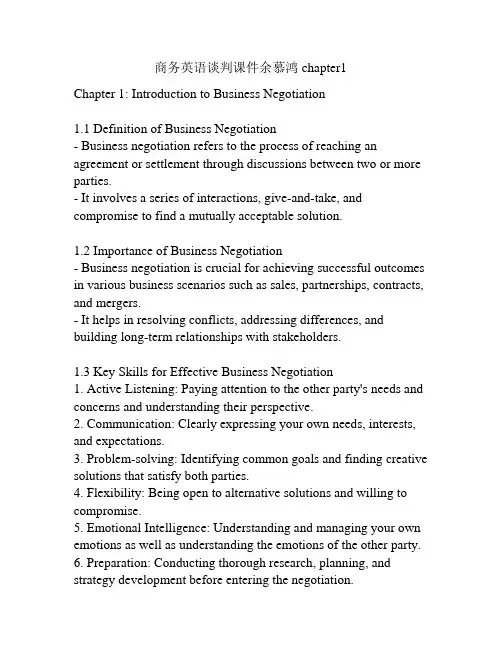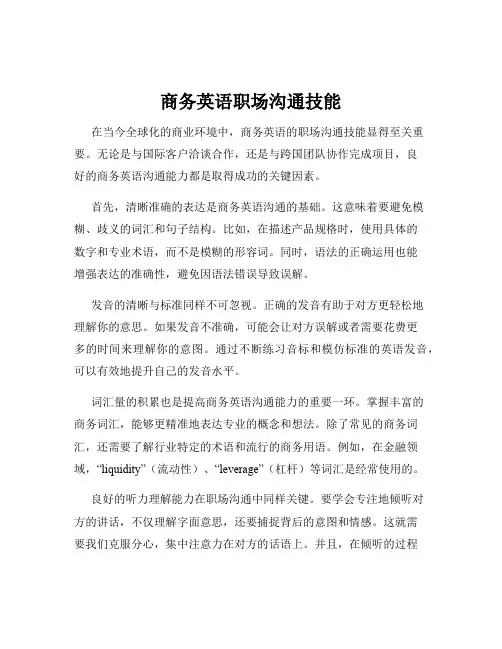商务英语谈判技巧
- 格式:docx
- 大小:13.59 KB
- 文档页数:3

商务英语口语:价格谈判,回复还盘的英语商务英语口语:价格谈判,回复还盘的英语1. We hope you will consider our counter-offer most favorably and tell us your decision at your earliest convenience.我方希望你方能考虑我们的还盘,给出一个最优惠的价格,并在方便的时候,尽早告诉我们你们的决定。
2. We wish you will consider you price and give a new bid, so that there can be a possibility for us to meet halfway.希望你们能重新考虑你们的价格,报出一个新的价格,这样我们双方才有可能各让半步。
3. To accept the prices you quote would leave us with only a small profit on our sales because the principal demand in or city is for articles in the medium price range.接受你们报价的话,留给我们的利润就不多了,因为我方市场对商品的主要需求是中等价格范围内的货物。
4. Your competitors are offering considerably lower prices and unless you can reduce your quotations, we shall have to buy elsewhere.你们的竞争对手所报的价格要低得多,除非贵方降低报价,否则我们就从其它地方购货。
5. To accept your present quotation would mean a heavy loss to us, not to speak of profit.如接受你方现报价格,对我方来说是一个重大损失,更不要说利润了。

商务谈判有什么方法商务谈判是商业领域中重要的沟通和协商方式,通过谈判双方的互动和讨价还价,以达成共同的利益和解决问题。
在商务谈判中,可以采用多种方法和技巧来促使双方达成一致。
本篇文章将讨论几种常见的商务谈判方法。
1. Win-Win(双赢)方法Win-Win方法强调通过合作和协商,使双方达成双赢的结果。
在这种方法中,双方努力找到共同的利益,而不是以对方的损失为代价来获取利益。
双方应该以协作的态度参与谈判,尊重彼此的需求和利益,并寻求一种解决方案,使双方都能获得最大的好处。
2. Competitive(竞争)方法竞争方法是一种更为激烈和对抗性的商务谈判方法。
在这种方法中,双方竞争争夺资源和优势地位,以实现自身的利益。
竞争方法强调个人和组织的利益,通常涉及价格谈判和其他对话形式的斗争。
虽然竞争方法可以对一方造成压力,但在某些情况下,它也可以产生一种积极的效果,通过公平和透明的竞争促使双方努力获得最佳结果。
3. Collaborative(合作)方法合作方法强调双方之间的协作和合作,寻求共同解决方案。
在这种方法中,双方共同努力,共享信息和资源,并与对方合作,以实现双方的共同目标。
合作方法侧重于建立信任和建立长期关系,强调双方共同利益的重要性。
通过合作,双方可以通过互相帮助和支持来实现更好的结果。
4. Compromise(妥协)方法妥协方法是商务谈判中常见的方法之一。
在这种方法中,双方都需要做出一些让步,以达成妥协。
妥协方法强调灵活性和双方的牺牲精神。
通过互相妥协,双方可以在各自的底线需求之间找到平衡点,并接受各自的一些损失,以实现一致。
5. Avoidance(回避)方法回避方法是商务谈判中一种较为消极的方法,指的是通过逃避或推迟谈判来规避问题。
这种方法适用于某些特定情况下,例如当双方无法达成共识或认为谈判可能会给双方带来更多问题时。
然而,回避方法并非一种理想的谈判方式,因为它可能会导致潜在的机会丧失和矛盾的进一步升级。

Business Collection商务必读2322012年5月 浅谈国际商务英语谈判技巧 河北建筑工程学院 王艳玲 徐海涛摘 要:伴随经济全球化步伐的加快,我国的国际贸易活动也日趋活跃,致使国际商务英语谈判也更加频繁。
成功的商务谈判有利于产生良好的经济和社会效益,熟悉谈判国家的文化、了解国际商务英语谈判中的相关技巧,是顺利完成国际商务谈判的前提。
本文归纳介绍了国际商务英语谈判的概况,并提出了几点谈判技巧,旨在为提高国际谈判的成功率做出贡献。
关键词:商务英语 谈判 技巧中图分类号:F740 文献标识码:A 文章编号:1005-5800(2012)05(b)-232-02伴随着我国整体经济实力的不断增强,许多富有竞争力的企业将未来发展的方向转向了国际,纷纷加大了拓展世界市场的力度,致使我国出口贸易活动日益频繁。
英语是目前国际贸易中的通用交流工具,在国际贸易谈判中起着关键性的作用。
为了实现贸易中的谈判目标,就需要利用英语表达自己的意见,互通信息,对相关事宜进行商谈,及达成最后的协议。
在此过程中尤其重要的是合理利用商务英语谈判技巧,有利于创造适宜的谈判气氛及良好的合作氛围,有利于彼此间建立友好、包容的伙伴关系。
1 相关概念的界定商务谈判,即是谈判的双方或多方为达成某种商品或者劳务的贸易,对其中涉及到的各种条件、利益进行磋商的活动。
由于市场经济的影响,商品概念的外延不断增大,不仅包含了具体的有形劳动产品,还涉及了信息、技术和服务等无形的产品。
商务谈判包含了所有商品形态的贸易洽谈,例如技术引进谈判、投资谈判等。
谈判的过程是自发给予与获取的过程,并且谈判双方会不断地调整其各种条件,同时也可以考虑随时退出。
因此,谈判作为每一次交易的核心部分,是一个无法避免冲突的,十分艰难和漫长的过程。
商务英语的构成包含了商务背景知识、语言的使用以及商务交际能力三个主要要素。
商务背景知识涉及的内容及其所占课程的比重主要由学习者的工作性质和其具备的专业化程度决定,商务背景的内容限定了该情景中应该用到的交际技能和相关的语言技能。

本文部分内容来自网络整理,本司不为其真实性负责,如有异议或侵权请及时联系,本司将立即删除!== 本文为word格式,下载后可方便编辑和修改! ==商务英语谈判议程商务英语谈判议程1、中方接待领美方代表入场,握手(welcome),美方由接待带领就坐,中方就坐。
中方主谈判:热烈欢迎美方代表的到来,我代表公司全体员工衷心祝愿这次谈判圆满成功。
美方主谈判:很感谢公司对我们的热情款待,希望我们的首次合作能够一帆风顺。
(I’m very grateful to company for your hospitality and I hope our first cooperation can be successful.)中方主谈判:这是我方准备的一份小礼物,也是我们此次将为贵公司提供的商品样本——佛山莨纱绸。
美方主谈判:非常感谢。
(Thanks very much).2、中方宣传部:鉴于这是我们的首次合作,下面由我来介绍一下本公司的相关情况。
(ppt展示)3、中方生产部:下面由我来介绍一下我们的产品。
应美国时代纺织品进出口有限公司要求,本次合作我方将提供的产品就是驰名中外的——佛山莨纱绸。
莨纱绸起源于晚清,有着近百年的历史了。
各位可以从你们手中的这块样品中看到,它分红黑两面,黑色面范着美丽的光泽,红色面又拥有奇妙的纹理。
莨纱绸被誉为世界上最凉爽的布料,各位可以摸一摸,感受一下。
美方集体(陆续发出):的确工艺精湛太妙了…...(Yes, indeed. It must have been gathered exquisite workmanship, is really wonderful.)中方生产部:为了让美方代表对我们的产品有更进一步的了解,下面请观看一段视频。
美方交头接耳片刻美方质检部:我们对你们的介绍十分满意。
但我们仍然有几个问题:首先我们想知道这种丝绸的特殊制作工艺是否对人体有不良反应。
( We are very pleased with your presentation, but, we still have a few questions..First, we want to know whether the special production process of this kind of silk will have adverse reactions on the human body.)中方生产部:这里有一份由中国和美国相关权威机构联合提供的一份质检报告,它包括了对莨纱绸的多项指标的测定,它证明了我们的产品是安全可靠的。

商务英语谈判课件余慕鸿chapter1Chapter 1: Introduction to Business Negotiation1.1 Definition of Business Negotiation- Business negotiation refers to the process of reaching an agreement or settlement through discussions between two or more parties.- It involves a series of interactions, give-and-take, and compromise to find a mutually acceptable solution.1.2 Importance of Business Negotiation- Business negotiation is crucial for achieving successful outcomes in various business scenarios such as sales, partnerships, contracts, and mergers.- It helps in resolving conflicts, addressing differences, and building long-term relationships with stakeholders.1.3 Key Skills for Effective Business Negotiation1. Active Listening: Paying attention to the other party's needs and concerns and understanding their perspective.2. Communication: Clearly expressing your own needs, interests, and expectations.3. Problem-solving: Identifying common goals and finding creative solutions that satisfy both parties.4. Flexibility: Being open to alternative solutions and willing to compromise.5. Emotional Intelligence: Understanding and managing your own emotions as well as understanding the emotions of the other party.6. Preparation: Conducting thorough research, planning, and strategy development before entering the negotiation.7. Patience: Remaining calm and composed during tense moments, and avoiding impulsive decisions.8. Negotiation Ethics: Upholding ethical standards and values such as honesty, fairness, and transparency in the negotiation process. 1.4 Different Approaches to Business Negotiation1. Competitive Approach: Focusing on one's own interests and trying to maximize benefits at the expense of the other party. This approach can lead to win-lose outcomes.2. Cooperative Approach: Collaborating with the other party to find mutually beneficial solutions. This approach aims for win-win outcomes.3. Integrative Approach: Combining elements of both competitive and cooperative approaches. It involves creating value through trade-offs and expanding the resources available to both parties. 1.5 Common Challenges in Business Negotiation1. Different Interests: Parties may have conflicting interests and priorities.2. Communication Barriers: Language barriers, cultural differences, and misinterpretations can lead to misunderstandings.3. Power Imbalance: One party may have more power or leverage in the negotiation, creating an uneven playing field.4. Emotions and Personality: Emotional reactions, egos, and personal conflicts can hinder the negotiation process.5. Time Pressure: Limited timeframes and deadlines can add pressure and impact decision-making.1.6 Strategies for Successful Business Negotiation1. Preparation: Gather relevant information, understand the otherparty's position, and define your own objectives.2. Building Rapport: Establish a positive relationship with the other party through trust, respect, and active listening.3. Finding Common Ground: Identify shared interests and goals to create a foundation for collaboration.4. Effective Communication: Clearly and concisely communicate your needs, preferences, and proposed solutions.5. Managing Emotions: Stay calm and composed, acknowledge emotions, and find constructive ways to address them.6. Flexibility: Be open to compromises and explore alternative options to reach a mutually satisfactory agreement.7. Closing the Deal: Ensure that the negotiated agreement is documented and all parties understand and accept the terms. References:- Lewicki, R. J., Saunders, D. M., & Barry, B. (2010). Negotiation: Readings, Exercises, and Cases.- Shell, G. R. (2006). Bargaining for advantage: Negotiation strategies for reasonable people. Penguin.- Salacuse, J. W. (2007). The global negotiator: Making, managing and mending deals around the world in the twenty-first century. Macmillan.。

商务英语职场沟通技能在当今全球化的商业环境中,商务英语的职场沟通技能显得至关重要。
无论是与国际客户洽谈合作,还是与跨国团队协作完成项目,良好的商务英语沟通能力都是取得成功的关键因素。
首先,清晰准确的表达是商务英语沟通的基础。
这意味着要避免模糊、歧义的词汇和句子结构。
比如,在描述产品规格时,使用具体的数字和专业术语,而不是模糊的形容词。
同时,语法的正确运用也能增强表达的准确性,避免因语法错误导致误解。
发音的清晰与标准同样不可忽视。
正确的发音有助于对方更轻松地理解你的意思。
如果发音不准确,可能会让对方误解或者需要花费更多的时间来理解你的意图。
通过不断练习音标和模仿标准的英语发音,可以有效地提升自己的发音水平。
词汇量的积累也是提高商务英语沟通能力的重要一环。
掌握丰富的商务词汇,能够更精准地表达专业的概念和想法。
除了常见的商务词汇,还需要了解行业特定的术语和流行的商务用语。
例如,在金融领域,“liquidity”(流动性)、“leverage”(杠杆)等词汇是经常使用的。
良好的听力理解能力在职场沟通中同样关键。
要学会专注地倾听对方的讲话,不仅理解字面意思,还要捕捉背后的意图和情感。
这就需要我们克服分心,集中注意力在对方的话语上。
并且,在倾听的过程中,适当地给予回应,如点头、简短的附和,让对方知道我们在认真倾听。
在书面沟通方面,邮件是商务英语中常见的交流方式。
邮件的格式应该规范、整洁,包括清晰的主题、恰当的称呼、正文内容的分段以及礼貌的结束语。
正文内容要简洁明了,重点突出。
避免冗长、复杂的句子结构,以免让收件人感到困惑。
同时,注意邮件的语气,要保持专业和礼貌,避免使用过于随意或情绪化的语言。
商务谈判是商务英语沟通中的重要场景。
在谈判中,要善于运用恰当的语言策略。
比如,使用委婉的表达方式提出自己的观点和要求,避免过于直接和强硬,以免引起对方的反感。
同时,要善于倾听对方的诉求,通过灵活的语言回应来寻求双方的利益平衡点。

商务英语谈判技巧在国际经济贸易发展中的作用商务英语谈判技巧在国际经济贸易发展中发挥了重要的作用。
随着全球化的深入发展,国际经济贸易的频繁进行,商务英语谈判技巧的运用能够促进各国之间的合作与沟通,提高谈判效果,实现双赢。
本文将重点探讨商务英语谈判技巧在国际经济贸易发展中的作用。
首先,商务英语谈判技巧有助于提高沟通效率。
国际经济贸易往往涉及到不同国家的政治、法律、文化等多个方面,涉及的问题复杂多样。
商务英语谈判技巧的灵活运用可以帮助谈判双方更加清晰地表达自己的意图和需求,减少信息交流的误解和偏差。
例如,通过运用言语和非言语交流技巧,谈判者可以适时地运用肢体语言、眼神交流等方式,加强自己的表达力,增强自信心,从而达到更好的沟通效果。
商务英语谈判技巧能够有效地减少谈判双方由于语言和文化差异而产生的交流障碍,提高谈判效率。
其次,商务英语谈判技巧有助于增强谈判双方的互信。
在国际经济贸易的谈判中,双方经常面对各种竞争和利益分配问题。
商务英语谈判技巧的使用能够帮助谈判者获取更多的信息,理解对方的真实意图,以及对方的底线和诉求。
通过积极倾听、善于观察和拆解问题的能力,谈判者能够迅速准确地把握对方需求,提供合理的解决方案,增强彼此的互信。
商务英语谈判技巧还包括有效地表达自己的观点和利益,并与对方建立良好的沟通信任关系,使谈判双方在合作中形成良好的互利共赢的格局。
再次,商务英语谈判技巧有助于制定有效的谈判策略。
在国际经济贸易的谈判中,各个国家都有自己的谈判目标和策略。
商务英语谈判技巧能够帮助谈判者在谈判开始前梳理谈判目标,制定合理的谈判策略。
例如,通过了解对方的文化背景和与之相关的商务英语礼仪,谈判者可以在谈判过程中更加恰当地运用礼貌用语和交际技巧,以达到更好的谈判效果。
商务英语谈判技巧还包括了解对方的利益点和底线,正确处理谈判中的利益分配问题,实现双方的共赢。
通过合理的谈判策略,商务英语谈判技巧能够最大限度地促成合作,推动国际经济贸易的发展。

商务英语之价格贵谈判1、称赞客户You know what? You have good eyes, it sells well. I believe you can have a very good profit on this product.你眼光很好,这产品卖的很好,你可以有一个非常好的利润。
2、问原因Can you advise the reason why you think our price is high, then we will double check and do our best to give you the answer.为什么觉得我们价格贵?3、质量&服务Once you place an order, we will advise you goods status from time totime to make sure perfect service.一旦你下订单,我们会随时向你汇报来保证完美的服务4、真实情感I like chatting with you, and I like you a lot, and already consider you asmy very good friend, so we are willing do business with you with very low margin, my friend, but can not do business with loss. .喜欢和你聊天,喜欢你,所以已经把你当非常好的朋友了,所以十分愿意不怎么赚钱也和你做生意,但是不能亏钱做生意(此处可以加表情哦)5、目标价格法Can you advise your target price?能否告诉目标价?6、小恩小惠After you place order, you are our VIP customer. Once we have new samples, we will send to you at the very first time, so that you can be thefirst one to test the market你下单后,就是我们的VIP客户。

浅谈商务英语谈判翻译原则及口译技巧应用摘要:一场成功的商务谈判是以谈判双方实现共赢为前提条件的,在具体的商务英语谈判交流和沟通时,谈判双方除了应当具备谈判项目所涉及到的相关业务和法律知识外,还应当熟练地掌握商务英语的翻译原则和口译技巧应用策略,只有严格掌握商务英语谈判的翻译原则,灵活地运用多种口译技巧和策略,才能够有效地使谈判双方进一步沟通,推动谈判进程,使双方都能够达到满意的结果。
本文以商务英语谈判的翻译原则和口译技巧为基本出发点,在着重分析了如何严格掌握商务英语谈判中的“礼貌原则”的前提下,提出了商务英语谈判中常见的口译技巧。
关键词:商务英语谈判翻译礼貌原则口译技巧一、引言商务谈判,顾名思义,就是指一切具有商品形态性质的各类经济体出于自身的经济利益或者为了满足其它经济实体的利益需求所进行的商务交易谈判。
商务谈判的大致有五种方式,主要为:技术合作、引进,商品转让、协商,投资、洽谈、贸易谈判等。
商务谈判的主要内容主要包括:产品技术、业务服务、信息咨询、技术支持等。
商务谈判主要是通过谈判双方的交流、沟通、洽谈来达到互相认可或者彼此之间的看法和认识的目的,通过商务谈判、洽谈来达到双方的合作协议,以实现彼此之间的商业经济利益最大化,并实现合作共赢。
所以,商务谈判的过程就有如一场战争,谈判双方时而因为争取各自的利益最大化展开斗智斗勇,进行激烈的博弈厮杀,时而因为争取共同的利益而放下分歧,协手合作,可见,商务谈判有如矛盾的两面性,双方存在利益统一的同一性又存在着利益纷争的斗争性,如何能够在商务谈判中如鱼得水,永远立于不败之地,是商务谈判永远的主题。
在信息技术快速发展,全球经济一体化的今天,绝大多数的商务谈判都是一个艰难、复杂的斗智斗勇的过程,可见,商务谈判的在商务洽谈、贸易中的重要程度。
二、商务英语的谈判翻译原则目前,全世界共有70余个国家使用英语,20余个国家将英语作为官方语言,所以,英语是全球通用语言,在商务谈判中统一使用英语已成为多数国家认可的国际惯例。

商务英语对话谈判商务英语口语涉及到不少英语中的专业词汇和知识,要想完全掌握,练就熟练口语并非一朝一夕,需要长时间的学习和累积。
下面小编整理了商务英语对话谈判,供你阅读参考。
商务英语对话谈判:商讨价格英语对话Peter:I'd like to get the ball rolling by talking about prices.我们从谈价格开始吧.Smith:Shoot. I'd be happy to answer any questions you may have.洗耳恭听.我很乐意回答你的任何问题.Peter:Your products are very good. But I'm a little worried about the prices you're asking.贵司产品非常不错,但我有点担心你的价格.Smith:You think we will be asking for more?你认为我们会要更多吗?Peter:That's not exactly what I had in mind. I know your research costs are high, but what I'd like is a 25% discount.那并不是我想的.我知道你们的研究成本是很高,但我希望能得到七五折.Smith:That seems to be a little high. I don't know how we can make a profit with those numbers.太高了.这样的折扣我们没有利润了.Peter:We said we want 10000pcs over a three-month period. What if we plan orders for a year, with a guarantee?我们接下来的三个月需要采购10000个,如果我们保证一年的订单怎么样?Smith:If you can guarantee that on paper,I think we can discuss this further.如果你能将你的保证写下来的话,我想可以考虑.英语知识点:1.I'd like to get the ball rolling by talking about prices."get the ball rolling"就是"开始做某事"的意思,"to make something start happening".也可以说是"set/start the ball rolling",意思不变.I'll start the ball rolling by introducing the first speaker. 我来介绍一下第一位讲演者作为开始.I'd like to get/start the ball rolling by doing sth是一句谈话,谈判时很好的.2.Shoot:(让某人把话说出来)说吧,请讲.比较的非正式.You want to tell me something? OK, shoot! 你有话要告诉我?那好,说吧!3.That's not exactly what I had in mind.Have(got) sth in mind:打算做某事,有心做某事What do you have in mind for dinner tonight? 你晚上想吃什么?How long have you had this in mind? 你想这件事多久了?大家要注意了,have sth in mind单纯地指想或者计划某事,不带感情色彩,而 have sth on sb's mind意思就大不一样了.Don't bother your father tonight─he's got a lot on his mind. 今晚就别打扰你父亲了--他的烦心事儿已经够多了.4.What if we plan orders for a year, with a guarantee?Order: 订货;订购;订单相关词组:Place an order for sth:订购某物I would like to place an order for ten copies of this book. 这本书我想订购十册.Can be made to order:可以定做These items can be made to order(= produced especially for a particular customer) 这几项可以订做.5.If you can guarantee that on paper,I think we can discuss this further.On paper: when you put something on paper, you write it down 写下来;笔录On paper还有一个意思,就是"仅照字面看;理论上", judged from written information only, but not proved in practice.例如,The idea looks good on paper. 仅就字面看,这个主意不错. 商务英语对话谈判:价格谈判常用句型1.Let's get down to business, shall we?(让我们开始谈生意好吗?)2.I'd like to tell you what I think about that.(我想告诉你我的一些想法。

商务英语谈判中的否定语言策略在商务英语谈判中,语言的运用至关重要。
否定语言策略的恰当使用,不仅能够清晰地表达立场和观点,还能避免冲突、维护关系,从而促进谈判的顺利进行。
一、商务英语谈判中否定语言策略的重要性商务谈判的本质是通过沟通和协商来达成共识、实现双方的利益诉求。
在这个过程中,不可避免地会出现需要表达否定意见的情况。
如果不能恰当地运用否定语言策略,可能会导致以下不良后果。
首先,可能会引起对方的反感和抵触情绪,破坏谈判的和谐氛围。
在商务交往中,人际关系的维护是至关重要的。
一旦对方感到被冒犯或不被尊重,可能会对谈判产生消极态度,甚至拒绝继续合作。
其次,不恰当的否定表达可能导致信息传递不准确,使对方误解自己的意图。
这会增加沟通成本,延长谈判时间,甚至可能使谈判陷入僵局。
最后,缺乏有效的否定语言策略可能会削弱自身的谈判地位和说服力。
无法清晰、有力地表达否定意见,可能会让对方认为自己立场不坚定或缺乏专业素养。
二、常见的否定语言策略1、委婉表达使用委婉的措辞可以减轻否定带来的冲击。
例如,用“I'mafraid”“I'm not quite sure”“It seems that”等开头,能够使语气更加缓和。
比如:“I'm afraid we can't accept your offer at the moment”(恐怕我们目前无法接受您的报价。
)2、提供替代方案在否定对方的提议或观点时,同时提供一个替代方案,既能表明自己的否定态度,又显示出积极解决问题的意愿。
例如:“We can't agreeto your proposed delivery date However, we could consider a later date thatis more feasible for both sides”(我们不能同意您提议的交货日期。
不过,我们可以考虑一个对双方都更可行的较晚日期。
Chapter 1 Principles of Business Negotiation商务谈判的原则何谓商务谈判?谈判是人们为了协调彼此之间的关系,满足各自的需要,通过协商争取达到意见一致的行为和过程。
Negotiation takes place between human beings. It is the most common form of social interaction. Almost everybody inthe world is involved in negotiations in one way or another for a good part of any given day. People negotiate over where to gofor dinner, which movie to watch or how to split household chores.Negotiation, in its modern sense, is defined in The Roots of Sound Rational Thinking as follows: the ability to deal with business affairs, to arrange by discussion the settlement of terms, to reach agreements through treaties and compromise, andto travel through challenging territory. All of these suggest a purposeful effort to resolve problems through talking andintellectual maneuvering. Negotiation includes consultation, bargaining, mediation, arbitration, and sometimes, even litigation.Competitive style To try to gain all there is to gain(竞争式谈判)Accommodative style To be willing to yield all there is to yield(通融式谈判)Avoidance style To try to stay out of negotiation(回避式谈判)Compromising style To try to split the difference or find (妥协式谈判) an intermediate point according tosome principleCollaborative style To try to find the maximum possible (合作式谈判) gain forboth parties----by carefulexploration of the interests of allparties----and often by enlarging the pieVengeful style To try to harm the other(报复式谈判)Self-inflicting style To act so as to harm oneself(自损式谈判)Vengeful and self-inflicting style To try to harm the other andalso(报复和自损式谈判) oneselfPeople who go for the competitive style are known as hard-bargaining negotiators. They start off with outrageous demands, using threats and other tactics to get what they want. One side typically starts out high and the other low. Afterseveral rounds of offer and counter-offer, the negotiators end up “spl itting the difference”. In this form, negotiation is viewed asa game where each side tries to get the best deal for themselves. Neither side exhibits concern for the other side.1.1Principle of Collaborative Negotiation合作式谈判的原则Ⅰ. Collaborative NegotiationNegotiation can also assume the form of collaborative style. It involves people with diverse interests working togetherto achieve mutually satisfying outcomes. Collaborative negotiation is known by many names. Some popular names include “problem-solving negotiation”, “consensus-building negotiation”, “interest-based negotiatio n”, “win-win negotiation”, “mutualgains negotiation”, and so on.The goal of collaborative negotiation is to manage the dispute so that the outcome is more constructive than destructive. A destructive outcome results in damages and involves exploitation and coercion. Aconstructive outcome fosters communication, problem-solving, andimproved relationships.● The negotiation parties have both diverse and common interests.● The common interests are valued and sought.● The negotiation process can result in both parties gaining something.● The negotiating arena is controlled by enlightened self-interest.● Interdependence is recognized and enhanced.● Limited resources do exist, but they can usually be expanded through cooperation and creativity.● The goal is a mutually agreeable solution that is fair to all parties and effective for the community/group.The collaborative negotiation focuses on interests rather positions. Integrative solutions are obtained by understandingother’s self-interests, not by jostling for positions.The collaborative negotiation places value on relationship. It requires trust and relies on full disclosure of relevant information.The disadvantages of this approach are:●It may pressure an individual to c ompromise and accommodate inways not in his best interest.●It avoids confrontational strategies, which can be helpful at times.●It increases vulnerability to deception and manipulation by a competitive opponent.●It makes it hard to establish defi nite aspiration levels and bottom lines.●It requires substantial skill and knowledge of the process.●It requires strong confidence in one’s perceptions regarding the interests and needs of the other side.Ⅱ. Principled NegotiationIn this form, each side of the negotiating parties attempt to meet the other side’s interest as well as their own. By thoroughly understanding their own interest as well as the other’s, both sides are often able to arrive at solutions neither alone could have envisioned or made possible. In this type of negotiation, each side recognizes and accepts the legitimate interests of the other side and they are committed to dealing with differences constructively in order to advance their own self-interests. This has been called “collaborativeprincipled negotiation”, a concept set forth by Roger Fisher and William Ury in their book Getting to Yes: Negotiating Agreement Without Giving In.Principled negotiation is particularly oriented to collaborative negotiations. However, it can be used in competitive negotiations and inother aspects of conflict management. It is a method that is centered around four considerations (PIOC):● People: Separate the people from the problem.● Interests: Focus on interests, not positions (inte rests always underlie positions).● Options: Invent options for mutual gains.● Insist on using objective criteria.1.Separate the people from the problemFisher and Ury pointed out that “negotiators are people first”. There are always relational and substantive issues in negotiation. The relational issue tends to become entangled with the problem and the positional bargaining puts relational and substantive issues in conflict with each other. Fisher and Ury suggested that the negotiators separate the relationship from the substance and deal directly with the people problem.It is a feasible to deal with a substantive problem and maintain a good working relationship between negotiating parties. People problems are usually caused by inaccurate perception, inappropriate emotions and poor communication. In order to deal with those problems, three techniques are recommended for both parties to follow:A.Establish an accurate perception.●Conflict, very often, is not caused by what happens, but by ho w people perceive what happens.●Increase the capability of each party to see the other side’s point of view (for example, by reversing roles).●Avoid blaming the other party for your problems.●Discuss each other’s perceptions of the problem.●Get the other party to participate in the mutual activities.●Seek to make negotiation proposals consistent with the other party’s values.B.Cultivate appropriate emotion.●Your emotion affects that of the other party.●Recognize and understand emotio ns of both parties.●Make emotions explicit and legitimate.●Allow the other party to let off steam.●Stay calm with the other party’s emotional outbursts.C. Strive for better communication.● Negotiation is a process of communicating between pa rties for the purpose of reaching a joint decision.● Be an active listener and acknowledge what is being said.● Speak to be understood.● Avoid criticism that may hurt the other party’s feelings.● Speak for a purpose.2. Focus on interests, not positionsIn such a case, negotiators need to distinguish between interests and positions and focus on interests not positions. A position is what you want or must have. An interest is why you want what you want.Positions can be thought of as a one-dimensional point in a spaceof infinite possible solutions. Positions are symbolic representations of a participant’s underlying motivating interests. In negotiation, there are many kinds of interests: multiple interests, shared interests, compatible interests and conflicting interests. Indentifying shared and compatible interests as “common ground” can be helpful in establishing a found for additional discussions. “Easy points of agreement”can be indentified and the principles underlying those easy points of agreement can often be extrapolated to help resolve other issues. Methods for focusing on interests instead of positions are as follows:A. Identify the self-interests.● Explore and recognize the interests of the other party that stand in your way.● Examine the different interests of different people on the other side.● Respect your counterparty as human beings and recognize the needs and interests that underlie their positions.B. Discuss interests with the other party.●Give your int erests a vivid description. Be specific.●Demonstrate your understanding of the other party’s interests and acknowledge them as part of the overall problemthat you are trying to solve.●Discuss the problems before proposing a solution.●Direct the discussion to the present and the future. Stay away from the difficulties of the past.●Be hard on the problem but soft on the people.3.Invent options for mutual gainsHere are the steps for overcoming the obstacles and developing multiple solution options:A.Separate the act of inventing options from the act of judging them.●Run a brainstorming session.☆Before brainstorming:■Define your propose----what you would like to achieve at meeting.■Choose a few participant (between five and ei ght people)■Change the environment----select a time and place distinguishing the session from regular discussions.■Design an informal atmosphere----talking over a drink, meeting at a vacation lodge or any other forms that make participants feel relaxed.■Choose a facilitator----a facilitator is needed to keep the meeting on track, make sure everyone gets a chance to speak, and stimulate discussion by asking questions.☆During brainstorming:■Seat the participants side by side facing the problem.■Clarify the ground rules, including the no-criticism rule.■Brainstorm.■Record the idea in full view.☆After brainstorm:■Check the most promising ideas----mark those ideas that participants think are the best.■Explore improvements for prom ising ideas----take one promising idea and explore ways to make it better and practical.■Set up a time to evaluate ideas and make a decision.●Consider brainstorming with the other side; it can be very valuable.B.Develop as many options as possible before choosing one.●Adopt the four types of thinking in generating options.●Look at the problem through the eyes of different experts.●Develop different versions of agreement.●Change the scope of a proposed agreement----break the problem into smaller units.C.Search for mutual gains.●Identify shared interests.●Dovetail differing interests.4.Insist on using objective criteriaThe guidelines for objective criteria are:●Independent of wills of all parties.●Legitimate and practi cal.●Acceptable to all parties.After identifying objective criteria and procedures, it is time to discuss them with the other party. There are three basic points to remember:A.Frame each issue as a joint search for objective criteria.B.Reason and be open to reason as to which standards are most appropriate and how they should be applied.C.Never yield to pressure, only to principle----yield to an argument or presentation that is based on reason and principle,not to one based on pressure.1.2Principle of Interest Distribution利益分配原则In negotiations at the domestic level, there are two types of interests involved: personal and organizational; at the international level, there are three: personal, organizational and national.Organizational RolesPrinciples and Agents1.3Principle of Trust in Negotiation信任的原则Trust is something of great importance in negotiation. Professor Richard C. Reuben defined it as “a state involving expectations about another’s motives and actions with re spect to oneself in situations entailing risk of uncertainty”. In the outline of his Negotiation----Law 5810, he states that there are three types of trust in professional relationships:●Deterrence-based trust (威慑型信任)☆ Calculus-based trust (预计型信任)●Knowledge-based trust (了解型信任)●Identification-based trust (识别型信任)Ⅰ. Trust Building in Negotiation1.Speak their language2.Manage your reputation3.Make dependence a factor4.Make unilateral concessions your concessions6.Explain your demandsIn their book entitled The Only Negotiating Guide You Will Ever Need, Peter B. Stark and Jane Flaherty list fifteen things that a negotiator can do to build trust with his counterpart.1.Demonstrate your competence2.Make sure the nonverbal signals you are sending match the words you are saying3.Maintain a professional appearancemunicate your good intentions5.Do what you say you are going to do6.Go beyond the conventional relationship7.Listen8.Over-communicate9.Discuss the indiscussibles10.Provide accurate information, without any hidden agenda11.Be honest----even when it costs you something12.Be patient13.Uphold fairness14.Negotiate for abundance, not scarcity15.Take calculated risksⅡ. Maximiz ing Joint Gain1.4Principle of Distributive, Integrative & Complex Negotiation两分法谈判、双赢谈判和复杂谈判的原则Ⅰ. Distributive NegotiationJennifer E. Beer listed a set of distributive bargaining strategies in Culture at work:1.Preparation2.Opening offers3.Exchange information and arguments4.Concessions and decisionsⅡ. Integrative Negotiation。
商务英语口语:45个国际商务谈判术语商务英语有很多的发展方向,比如翻译、外贸、教师等等很多选择。
不过,不管你希望往哪个方向去发展,一些国际通用的谈判知识,还是可以先了解的。
下面我们就来看下,专业的商务谈判中,各种技巧及原则的英文释义吧!1、Bargaining讨价还价petitive, win-lose situations.2、Selective perception 选择性感知When the perceiver singles out certain information that supports a prior belief and filters out information that does not confirm that belief.3、Intangibles无形因素intangible factors are the underlying psychological motivations that may directly or indirectly influence the parties during a negotiation.4、Interdependent相互依赖when the parties depend on each other to achieve their own preferredoute they are interdependent.5、Negotiator’s dilemma谈判者的困境the choice of whether to pursue a claiming value strategy is described as the “negotiator’s dilemma”.6、initial offer最初报价the first number the buyer will e to the seller.7、petitive situation竞争性情形:when the goals of two or more people are interconnected so thatonly one can achieve the goal, this is petitive situation, also known as a zero-sumor distributive situation,in which “individuals are so linked together that there is a negative correlation between their goal attainments”.8、Mutual-gainssituation相互获益情形: When parties’goals arelinked so that one person’s goal achievement helps others to achieve theirgoals, it is a mutual-gains situation,also known as a non-sum or integrative situation.9、BATNA达成谈判协议的最佳选择an acronym for best alternative to a negotiated agreement.10、Thedilemma of honesty诚实困境it concerns how much of the truth to tell the other party.11、Thedilemma of trust信任困境it concerns how much should negotiators believe what the other party tells them.12、Distributive bargaining分配式谈判accepts the fact that there can only be one winner given the situation and pursues a course of action to be that winner.13、Integrative bargaining共赢争价attempts to find solutions so both parties can do well and achieve their goals.14、Claimvalue主张价值to do whatever is necessary to claim the reward, gain the lion’s share, or gain the largest piece possible.15、Createvalue创造价值to find a way for all parties to meet their objectives, either by identifying more resources or finding unique ways to share and coordinate the use of existing resources.16、Stereotypes心理定势is a very mon distortion of the perceptual process. It occurs when one individual assigns attributes to anothersolely on the basis of the other’s membership in a particular social or demographic category.17、Contending争夺战略actors pursuing the contending strategy pursue their own outes strongly and show little concern for whether the other party obtains his or her desired outes.18、Yielding屈服战略actors pursuing the yielding strategy show little interest orconcern in whether they attain their own outes, but they are quite interested in whether the other party attains his or her outes.19、Inaction不作为战略actors pursuing the inaction strategy show little interest in whether they attain their own out-es, as well as little concern about the other party obtains his or her outes.20、Problem solving解决问题战略actors pursuing the problemsolving strategy show high concern for attaining their own outes and high concern for whether the other.21、target point目标点the point at which negotiator would like toconclude negotiations.22、resistance point拒绝点a negotiator’s bottom line, the mostthe buyer will pay or the smallest amount the seller will settle for.23、a positive bargaining range积极的谈判空间the buyer’s resistance is above the the seller’s, and the buyer minimally willing to pay morethan the seller is minimally willing to sell for.24、Reciprocity互惠主义when you receive sth from another person, you should respond in the future with a favor in return.25、The winner’s curse赢家的诅咒the tendency of negotiators, particularly inan auction setting, to settle quickly on an item and then subsequently feel disfort about a negotiation win that es too easily.26、Process-basedinterests基于谈判过程的利益related to how the negotiators behave as they negotiate.27、indirect assessment间接估计determining what information an individual likely used to set targetand resistance point and how he or she interpreted this information.28、ive presentation选择性表述negotiators reveal only the facts necessary to support their case.29、Pareto efficient frontier帕累托有效边界the claiming value line is pushed towards the upper right-hand side to the fullest extent possibleby creating value, and the line is called the Pareto efficient frontier.30、shared goal共享目标the goal that both parties work toward but that benefits each party differently.31、joint goal联合目标the goal thatinvolves individuals with different personal goals agreeing to bine them in a collective effort.32、Endowment effect捐赠效应The tendency to overvalue something you ownor believe you possess.33、Relationship-basedinterests基于双方关系的利益tied to the current or desired future relationship between theparties.34、Resistance point拒绝点a resistance point is the place where you decide that you should absolutely stop the negotiation rather than continue because any settlement beyond this point is not minimally acceptable.35、Alternatives可替代的选择other agreements negotiators couldachieve and still meet their needs.36、Target point目标点one realistically expects to achievea settlement and the asking price, representing the best deal one can hope toachieve.37、Halo effects晕轮效应rather than using a person’s group membership as a basis for classification, however,halo effects occur when people generalize about a variety of attributes basedon the knowledge of one attribute of an individual.38、Projection投射效应When people assign to others the characteristics or feelings that they possess themselves.39、Mythical fixed-pie beliefs固定蛋糕观念those who believe in the mythical fixed-pie assume there is no possibility for integrative settlements and mutually beneficial trade-offs, and they suppress efforts to search for them.40、Anchoring and adjustment基准调节cognitive biases in anchoring and adjustmentare related to the effect of the standard (or anchor)against which subsequent adjustments are made during negotiation.41、Issue framing and risk谈判框架的制定方式与风险the way a negotiation is framedcan make negotiators more or less risk averse or risk seeking.42、Availability of information信用的可用性in negotiation, the availabilitybias operates when information that is presented in vivid, colorful, orattention-getting ways bees easy to recall, and thus also bees centraland critical in evaluating events and options.43、The law of small numbers小数法则in decision theory, the law of small numbersrefers to the tendency of people to draw conclusions from sle sizes. Innegotiation, the law of small numbers applies to the way negotiator learn and extrapolate from their own experience.44、Self-serving biases感知错误The tendency to overestimate the causal roleof personal or internal factors and underestimate the causal role of situationalor external factors, when explaining another person’s behavior.45、Ultimatum最后通牒an ultimatum is an attempt to induce pliance or force concessions from a presumably recalcitrant opponent.。
浅谈商务英语在国际商务谈判中的技巧及语言艺术应用摘要:在全球经济一体化的时代背景下,国际贸易迅速发展,国际间经常展开贸易谈判。
本文就“商务英语在国际商务谈判中的技巧及语言艺术”这一问题提出作者个人的看法,以期与大家交流共享。
关键词:商务英语国际贸易谈判概念技巧一、商务英语的概念商务英语是指在人们进行商务活动过程中所使用的技能型、实用型英语语言。
随着我国经济快速发展以及改革开放程度的不断深化,商务英语在我国参与国际贸易交流与谈判过程中发挥着越来越重要的作用。
二、商务英语在国际商务谈判中的礼貌技巧无论谈判对手来自哪个国家,谈判内容是什么,谈判都需要在和谐融洽的氛围下进行才能取得良好的谈判效果。
因此,在国际贸易谈判中,我们必须遵守社交礼仪、巧妙运用礼貌技巧,在让对方感觉到自己受到尊重的同时,取得预期的谈判成果。
下面我们就商务英语在国际商务谈判中的礼貌技巧进行详细分析:(一)利用礼让表述法进行谈判在谈判中,尽量以对方的视角来阐述问题,避免频繁出现“i”、“we”、“our”等主观性很强的词语,而是尽量多用“you”、“your”等词语作为句子的中心语,让对方感觉自己处于交谈的主导位置,受到了充分的尊重与认可。
如此一来,能够使谈判在和谐友好的氛围下进行,并且让对方更加容易接纳我方的观点和条件。
(二)以保护对方利益为出发点进行谈判谈判双方的目的都是为了最大限度的为自己争取利益,然而如果利益仅仅偏向于其中一方,那么这种合作关系必然不能长久。
因此,在商务谈判过程中,应该多从对方的利益进行考虑,争取实现谈判双方的双赢。
这样,对方才更加容易对我方产生信任感,对于我方的提议和要求也更加容易接受,使谈判顺利进行。
比如,在“by sending your check for 280 today,you would be able to keep your resent credit reputation.”这句话中,既明确表达了我方的意图,又让对方认识到本次的商务活动对他们企业也是有益的,那么对方就容易接受我方的建议,达成合作关系。
商务英语谈判技巧
商务英语谈判技巧
商务谈判前如果是初次见面,一般采用握手的礼节。
握手者双目注视对方,微笑,问候,致意,不要看第三者或显得心不在焉。
除
了关系亲近的人可以长久地把手握在一起外,一般都是握一下即可。
上下级之间,上级伸手后,下级才能接握;主人与客人之间,主人宜
主动伸手;男女之间,女方伸手后,男方才能伸手相握;当然,如果
男方为长者,则遵照前面所说的'方法。
不要使自己有紧盯或逼视对方的样子,才被认为有礼貌。
与人谈话时,不要用手指指人,不宜与对方离得太远或太近。
不要过于兴奋,过多的手势会被认为不得体。
对女士衣饰可予以赞扬,但不要问人家是花多少钱买来的等问题。
商务谈判前要牢记对方的姓名和职位。
为使交谈进行下去,可以开始纯属交际性的谈话,如天气等,这在很多国家都是可行的。
商务谈判前要把在座的每一个人都介绍到。
除了介绍名字之外,提供一些个人背景情况,有助于介绍双方进一步交谈。
西方人通常不像中国人和日本人那样在介绍时彼此递送名片,他们通常只有在商务活动中才使用名片商务英语谈判技巧商务英语谈
判技巧。
在下面的对话中,CarolJacobs是一家合资公司总部的一名高级
主管人员。
她出差到了这家公司的亚洲地区分公司(在北京合资)。
主管亚洲地区业务的副主席会见了她。
David:Goodmorning,Carol.It'sgreattoseeyouagain.Didyouhav eagoodtripover?
早上好。
Carol,再次见到你真好。
你旅途还愉快吧?
Carol:Yes,itwasagoodflight.Iwasalittletiredyesterday,but I'mOKnow.
唔,还不错。
昨天还有点累,现在没事儿了。
David:Great!Ifyou'reready,I’dliketointroduceyoutosomeof ourkeypersonnel.
太好了!如果你已经准备好了的话,我想把您介绍给这儿的主要工作人员。
Carol:Let'sgo.
咱们走吧。
David:Carol,thisisKathyChen,ourFinancialOfficer.Kathy,I' dlikeyoutomeetCarolJacobs.
Carol,这是KathyChen,我们的财务主管,Kathy,这是CarolJacobs。
Carol:I'mpleasedtomeetyou,Kathy.You’redoingagreatjob.Th edivision'sfinancesareintopshape.
见到你真高兴,Kathy。
你干得太棒了。
分公司的财务达到了最佳的状态。
Kathy:Thankyou,MsJacobs.I'mhappytomeetyou,too.
谢谢,Jacobs小姐。
见到您我也很高兴。
David:AndthisisBenGuo.He'sinchargeofMarketing.Ben,letmei ntroduceCarolJacobs.
这是BenGuo。
他主管营销。
Ben,我来介绍一下CarolJacobs。
Ben:Howdoyoudo,MsJacobs?
你好,Jacobs女士。
Carol:It'sapleasuretomeetyou,Ben.Soyou’retheoneresponsi bleforthoseoutstandingsalesfiguresI'veseen.
见到你很荣幸,Ben。
我看过的那些了不起的销售数字,全是由你带领创下的商务英语谈判技巧默认。
Ben:Thankyou.ImustsayIhaveagreatstaff.
谢谢,我得说那是因为我们有一个了不起的团队。
David:Ithinkyou'llfindallofourstaffistop-notch.
我想你会发现我们所有的员工都是一流的。
Carol:I'malreadyconvincedofthat,fromthereportsI’veseen. Well,I'dliketoseeourmanufacturingoperationnow,ifIcould.
这些报告已经说服我了。
嗯,如果可以的话,我想看看我们的制造车间。
David:Surething!Rightthisway.
当然!这边请。